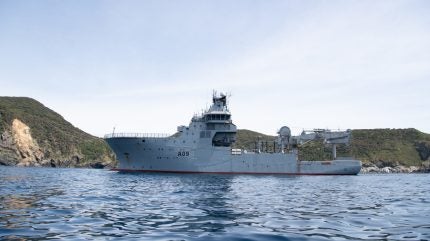
The HMNZS Manawanui grounded off the Samoan coast, capsizing the following day.
A coordinated rescue effort led by the New Zealand Defence Force (NZDF) and the Rescue Coordination Centre saved all 75 crew and passengers. Investigations into the incident and environmental impact are underway.

Discover B2B Marketing That Performs
Combine business intelligence and editorial excellence to reach engaged professionals across 36 leading media platforms.
In a high-seas emergency, the Royal New Zealand Navy vessel HMNZS Manawanui ran aground off the southern coast of Upolu, Samoa, on Saturday evening, 5 October 2024. The vessel, conducting a hydrographic survey mission, became stranded just 1 nautical mile from shore. All 75 people were rescued following an operation, however, the boat eventually capsized and sank.
Challenging conditions
At 7:52pm on Saturday, the crew and passengers began evacuating into lifeboats. Rescue efforts were led by the Rescue Coordination Centre New Zealand (RCCNZ), supported by the NZDF. Multiple vessels responded to distress calls, and a Royal New Zealand Air Force P-8A Poseidon was deployed to assist. Rescuers faced challenging conditions, including strong currents and winds that pushed lifeboats towards dangerous reefs, compounded by heavy swells.
“We are very grateful for the assistance of everyone involved, from RCCNZ, who coordinated rescue efforts, to the vessels which responded and took our crew and passengers from Manawanui to safety,” said Maritime Component Commander Commodore Shane Arndell.
Though the exact cause of the grounding remains unknown and is under investigation, it was confirmed by 9:00am on Sunday that the HMNZS Manawanui had capsized and submerged. The NZDF is working closely with the Samoan government and environmental authorities to assess and mitigate any potential environmental damage caused by the incident.

US Tariffs are shifting - will you react or anticipate?
Don’t let policy changes catch you off guard. Stay proactive with real-time data and expert analysis.
By GlobalDataIn the immediate aftermath, the crew and passengers were safely transferred ashore with support from the Samoan authorities and the New Zealand Ministry of Foreign Affairs and Trade (MFAT). On Sunday evening, a Royal New Zealand Air Force C-130J Hercules flew to Apia, carrying medical personnel, a dive team, and light clean-up equipment to assist recovery operations.
New Zealand recently received its first of five C-130J Super Hercules aircraft from Lockheed Martin. The new fleet will replace the ageing C-130H models. The handover ceremony took place on 8 August 2024.
By 7 October, a second C-130H Hercules returned to New Zealand with the remaining equipment. That same evening, 72 rescued personnel were flown back to RNZAF Base Auckland, where they will undergo further debriefings and medical assessments. Rear Admiral Golding confirmed that some personnel had required medical treatment following the incident.
Investigation into the cause of grounding underway
The HMNZS Manawanui, a key vessel in the New Zealand Navy’s operations, was on its third deployment to the South West Pacific this year. The ship had scheduled engagements across several Pacific territories, including the Kermadec Islands, Samoa, Tokelau, and Niue, with a return date to New Zealand set for 1 November. A formal Court of Inquiry has been initiated to determine the causes behind the incident.
GlobalData’s intelligence on New Zealand’s defence market highlights that the Royal New Zealand Navy had only acquired the auxiliary vessel in 2019.
As the NZDF coordinates the safe return of its personnel, environmental monitoring teams remain in Samoa to address potential ecological risks while the investigation into the grounding continues.
In other recent Royal New Zealand Navy developments, auxiliary vessel HMNZS Aotearoa completed its longest at-sea refuelling mission since entering service in 2020, transferring 3.35m litres of fuel to the US Navy’s USS Boxer, a Wasp-class amphibious assault ship.





